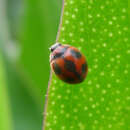en
names in breadcrumbs


In the Middle Ages, certain species of coccinellid beetles were dedicated to the Virgin Mary and named "beetles of Our Lady." As time progressed ladybird beetles, ladybirds, or ladybugs became popular names with English-speaking children.
Rodolia cardinalis is native to Australia. However, in 1868 Icerya purchasi, a cottony cushion scale (and also from Australia), was introduced to California accidentally as a serious pest of citrus in California. In 1888-1889 R. cardinalis was intentionally introduced to California because it was a natural predator of the scale. In less than 2 years the scale was under complete control and R. cardinalis adapted and flourished in the new environment. Its distribution now includes Australia, the United States, and Europe.
Rodolia cardinalis is extremely sensitive to some insecticides such as Baythroid, commonly used on citrus crops. Global populations are strong however, and require no special conservation status.
US Federal List: no special status
CITES: no special status
In its North American habitat, the vedalia beetle has no natural predators and so can outcompete native ladybugs which also offer important pest control benefits.
Rodolia cardinalis is used commercially to combat scale insects injurious to citrus orchards, specifically Icerya purchasi, the cottony cushion scale. Orchard owners use this form of Integrated Pest Management(IPM)--use of a variety of strategies for the control of insect pests, including cultural, chemical, and biological controls while restricting and altering the use of pesticides--to control a pest population always present. The natural predator of Icerya Purchasi is used (R.cardinalis) instead of pesticides and other such materials. Aggregations of the beetle are collected by the bushel and sold to citrus growers. When imported from Australia to California in the 19th century,they brought with them no natural predators, making them an ideal animal to use for pest management.
Positive Impacts: controls pest population
Both adults and larvae are voracious predators. Homopteran pests including aphids, scale insects, mealy bugs, and mites are food for R. cardinalis. Adults and larvae search the foliage of bushes and trees in search of prey.
Animal Foods: insects
Primary Diet: carnivore (Insectivore )
Although native to Australia, Rodolia cardinalis flourishes today throughout Australia, the United States, and Europe in areas where citrus is grown.
Biogeographic Regions: nearctic (Introduced ); palearctic (Introduced ); australian (Native )
Rodolia cardinalis are specialists, feeding on Icerya purchasi which in turn specialize on citrus trees. For this reason, Rodolia cardinalis live in citrus orchards and nearby hills and scrubland in areas where Icerya purchasi are also found. In addition to citrus, cottony cussion scales are found on Acacia, boxwood, citrus, magnolia, Nandina, olive, Pittosporum, and rose plants, which therefor additionally provide habitat for the vedalia beetle.
Habitat Regions: tropical ; terrestrial
Terrestrial Biomes: savanna or grassland
Other Habitat Features: suburban ; agricultural
This species of ladybeetle, like others, has a very distinctive shape. The body is broadly oval to nearly spherical, and is strongly convex dorsally and nearly flat ventrally. The head has short antennae and is partly or completely concealed by the pronotum. Females are very red in color, while males are more black although fine body hairs often obscure the color pattern and give a decidedly grey appearance. Eggs are bright red. Mature larvae are pinkish with black markings and often have a blueish tinge.
Other Physical Features: ectothermic ; heterothermic ; bilateral symmetry
Sexual Dimorphism: sexes colored or patterned differently; female more colorful
Rodolia cardinalis reproduces sexually. In warm climates there are several generations each year. The bright red eggs are laid on the egg sac of the cottony cushion scale in small, closely packed masses of one or two dozen. Upon hatching, the small pinkish larvae immediately enter the sac and feed on the scale eggs. These larvae are usually found in aphid colonies.
Range eggs per season: 150 to 190.
Key Reproductive Features: iteroparous ; year-round breeding ; sexual ; fertilization (Internal ); oviparous